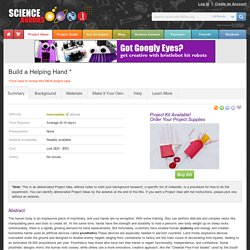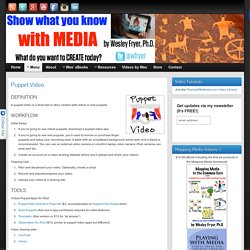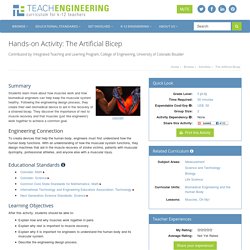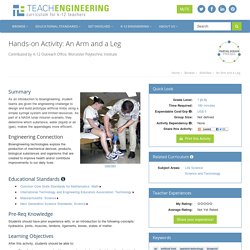

Kids Ahead - Robotics Activities - I Want To Hold Your Hand. Build a Helping Hand. *Note: This is an abbreviated Project Idea, without notes to start your background research, a specific list of materials, or a procedure for how to do the experiment.

You can identify abbreviated Project Ideas by the asterisk at the end of the title. If you want a Project Idea with full instructions, please pick one without an asterisk. Abstract The human body is an impressive piece of machinery, and your hands are no exception. With some training, they can perform delicate and complex tasks like manipulating pens and tools to create art. In this science project, you will design and create your own prosthetic hand model and put it to the test. Before you start creating, you might want to do some background research on the anatomy of human hands. Once you have plenty of information, you will probably be eager to start creating. Puppet Video » Show What You Know with Media. A puppet video is a short skit or story created with virtual or real puppets.

Initial Setup If you’re going to use virtual puppets, download a puppet video app.If you’re going to use real puppets, you’ll need to borrow or purchase finger puppets and setup your recording area. A table with an uncluttered background works well, and a tripod is recommended. You can use an external video camera or a built-in laptop video camera. iPad cameras can work well too.Create an account on a video sharing website where you’ll upload and share your videos. Ongoing Use Plan and storyboard your video.
Virtual Puppet Apps for iPad Puppet Pals Director’s Pass HD ($3, recommended) or Puppet Pals Pocket (free)Sock Puppets (free but in-app purchases required for extra features)Toontastic (free version or $13 for “all access”)iStopmotion for iPad ($10, similar to puppet video apps but different) Video sharing sites * Image attribution: Digital drawing created by Wesley Fryer on Brushes for iPad. I Like to Move It: Motorizing a Robot Hand. *Note: This is an abbreviated Project Idea, without notes to start your background research, a specific list of materials, or a procedure for how to do the experiment.

You can identify abbreviated Project Ideas by the asterisk at the end of the title. If you want a Project Idea with full instructions, please pick one without an asterisk. Abstract Imagine how cool it would be to have your own motorized robot hand. Well, stop imagining and turn that daydream into reality!
How to Make a Cardboard Arm - (Physic Project) The Artificial Bicep. Summary Students learn more about how muscles work and how biomedical engineers can help keep the muscular system healthy.

Following the engineering design process, they create their own biomedical device to aid in the recovery of a strained bicep. They discover the importance of rest to muscle recovery and that muscles (just like engineers!) Work together to achieve a common goal. Engineering Connection To create devices that help the human body, engineers must first understand how the human body functions. Educational Standards Each TeachEngineering lesson or activity is correlated to one or more K-12 science, technology, engineering or math (STEM) educational standards.
All 100,000+ K-12 STEM standards covered in TeachEngineering are collected, maintained and packaged by the Achievement Standard Network (ASN), a project of JES & Co. Click on the standard groupings to explore this hierarchy as it applies to this document. Learning Objectives After this activity, students should be able to: Class-pack-hydraulics-booklet.pdf. Plans.pdf. Hydraulic Arm. Hydraulic robot made of cardboard and scotch duct tape. An Arm and a Leg. Each TeachEngineering lesson or activity is correlated to one or more K-12 science, technology, engineering or math (STEM) educational standards.

All 100,000+ K-12 STEM standards covered in TeachEngineering are collected, maintained and packaged by the Achievement Standard Network (ASN), a project of JES & Co. (www.jesandco.org). In the ASN, standards are hierarchically structured: first by source; e.g., by state; within source by type; e.g., science or mathematics; within type by subtype, then by grade, etc. Click on the standard groupings to explore this hierarchy as it applies to this document. Pre-Req Knowledge Students should have prior experience with, or an introduction to the following concepts: hydraulics, joints, muscles, tendons, ligaments, bones, states of matter.
Introduction/Motivation Your engineering challenge: NASA is setting up a workstation on the moon. Assessment Pre-Activity Assessment: Have students draw diagrams of arms and/or legs. DESIGN SQUAD NATION . Build. Grasping with Straws: Make a Robot Hand Using Drinking Straws. Please ensure you have JavaScript enabled in your browser.

If you leave JavaScript disabled, you will only access a portion of the content we are providing. <a href="/science-fair-projects/javascript_help.php">Here's how. </a> Abstract. Grabber (Picker, reaching claw) tool. Extending Grabber.